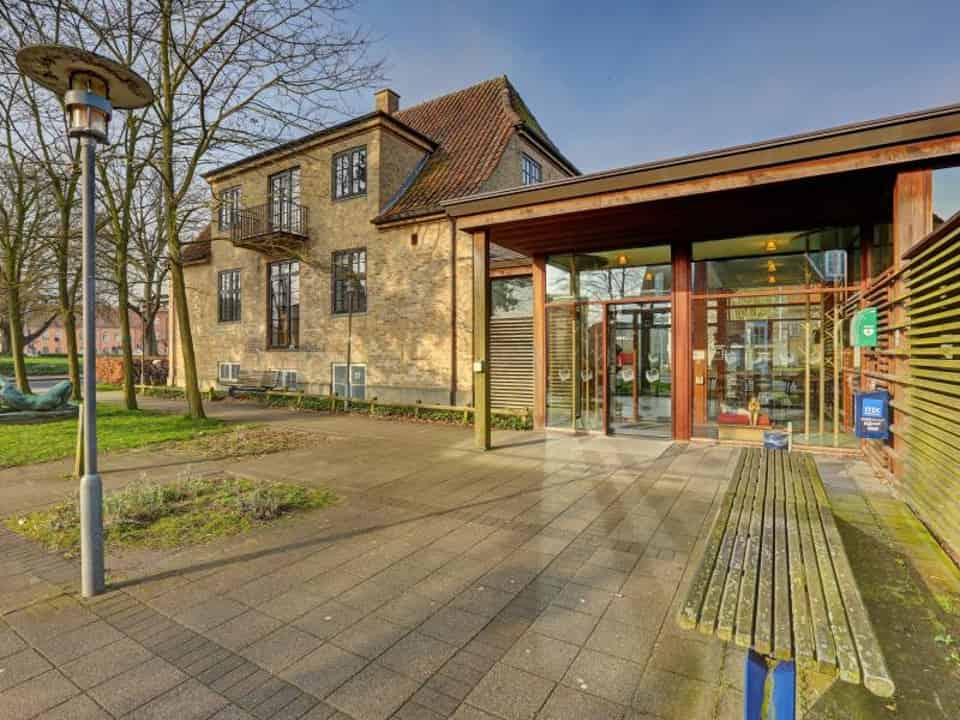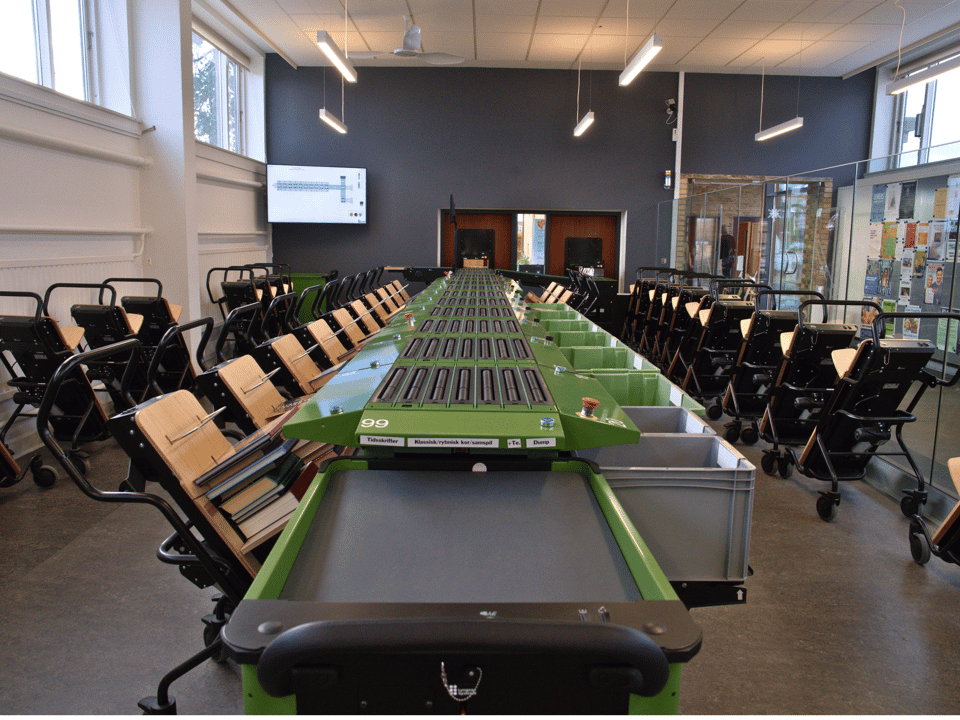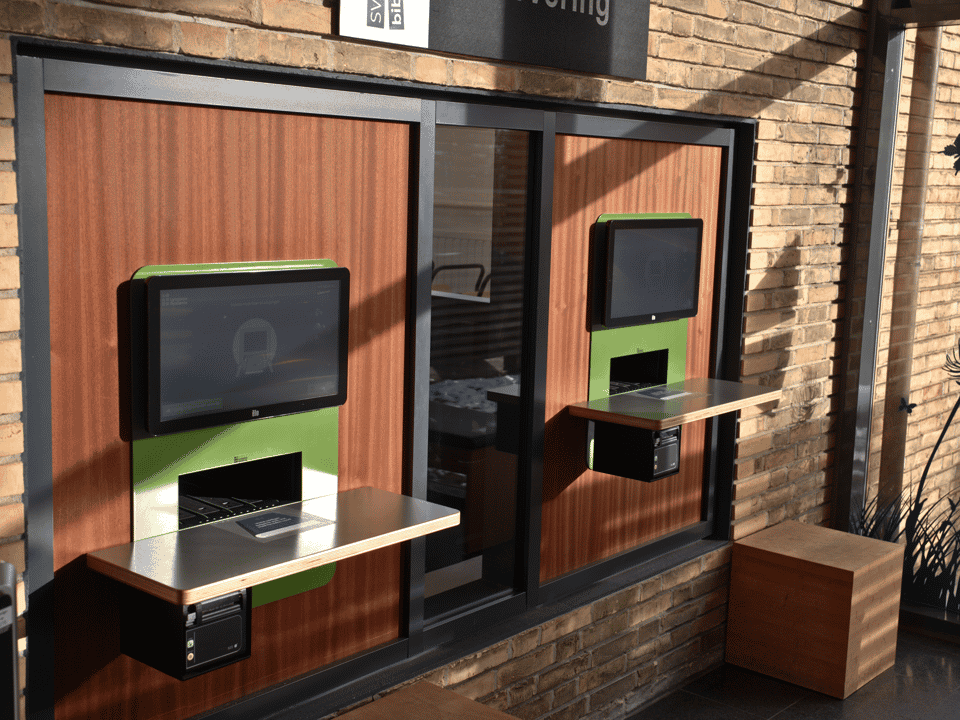Case Story: Svendborg Library
Automation Increases Meaningful Patron Time
When Svendborg Library decided on an automatic book sorter, the decision was rooted in a desire to improve working conditions for staff as their circulation numbers rose. With the sorter, manual labor was decreased while the staff gained time for more meaningful patron interactions – something the library believes will secure their survival in the future.

About the Library
Svendborg Library is located on the south coast of Funen, Denmark, and consists of a central library and six branch libraries. To create a library where people encounter knowledge and culture communicated through staff, exhibitions, and events that make them more enlightened, better equipped for everyday life, and strengthen their sense of belonging, the library offers a variety of programs and resources to their community.
Before
A Chance to Improve Work Conditions
Over the past years, the circulation numbers have been climbing at Svendborg Library. With no automated material handling solution, all book sorting was done manually by the staff, but with rising numbers, the manual labor was proving too strenuous:
“We had a number of statements from our front desk staff that they had pain in their shoulders, hands, and joints from work that had to do with our flow, i.e., material handling. We really wanted to do something about that. We had the chance to do so when we freed up an area after citizen services moved out, and we made sure to seize the opportunity. We could see that there was also the physical framework for it now.” says Anne Green, Branch Manager at Svendborg Library.
Placed in older buildings in the center of the city, the space for a large sorter was not a given. However, with the decision to move citizen services out of the library, the possibility was apparent, so the process of acquiring a solution began.
During
Transparent Offers and Input from Other Libraries
As Svendborg Library began acquiring an automated book sorter, they looked at it from two angles. They reached out to Lyngsoe Systems Library Solutions and another company for offers and to other libraries nearby to learn from their experiences with automated material handling.
“We drew on the experiences of others in the library world who had a solution from one company or the other. We talked to many different ones in the run-up phase. One of the things that stuck out to us was actually the service agreement. Both support and the service agreement from Lyngsoe were things that other libraries spoke positively about," Anne Green explains.
While the experiences of others proved helpful in the decision-making process, the collaboration between the library and Lyngsoe was also significant for the final choice.
“It was also important that it was relatively transparent what we were getting for our money and what was included in the total budget in this offer. We felt that the offer was transparent and that everything we needed was covered. When we talked to Dennis (sales manager at Lyngsoe) about our requirement specifications and the whole process of arriving at a proper offer, we felt that there was a pretty good responsiveness and understanding of what we needed and a good process around it. It resulted in a well-rounded offer that we could understand and made sense," Anne Green elaborates.
Visiting Libraries Helped Staff Understand the Purpose
Part of the communication with other libraries led Svendborg to visit two different libraries with automatic book sorters from Lyngsoe, Middelfart and Odense. While Odense has a very large system, Middelfart was more comparable in terms of the number of materials that pass through the sorter. As part of the visit, Svendborg Library brought as many front desk staff as possible. Because while the decision to automate the material handling came from a desire to improve working conditions, a slight skepticism still roamed among some staff.
“Seeing it physically, that helped a lot. We brought a lot of our front desk staff. As many as possible so that those who were going to work with it could see it in operation and hear from people who worked with it. I think that helped a lot in terms of the internal understanding of what we were doing” Anne Green says.
Luckily, the visit helped gradually convince the staff that the sorter would make their jobs easier and that the change would be worth it in the end.
“I thought that this must be a gift, but in the beginning, the reactions were actually a bit mixed. But then, gradually, it became more and more positive, especially when they were out to see how it worked. Then the reactions were, "That's pretty smart," and now that we have had the sorter for almost a year, people really do see the benefit," Anne Green continues.
After
A Big Change in the Daily Work
With the new sorter and the accompanying Lyngsoe Ergo Carts™ and Bins, Svendborg Library had their daily material handling changed drastically. Though the carts still need to be sorted, and the books still need to be shelved by hand, the sorter has made a significant change in their day-to-day work. Especially the switch from large book trolleys to Ergo Carts has been a positive change, even if that was not the initial response from staff:
“In the beginning, it was actually somewhat negative, “it cannot hold as many books as the old ones, so we have to change the cart in the sorter all the time," and so on. But on the other hand, it is nicer to have to handle fewer books and put fewer books away at a time. It does not seem as overwhelming as a cart that can hold more and is crammed. So that has actually become a positive thing for us in these Ergo Carts” says Anne Green.
More Time for Patrons Now and in the Future
In addition to improving staff working conditions, part of the reasoning behind investing in an automatic book sorter was to give the staff more time to be present with the patrons. The time that was no longer spent manually sorting all items could instead be used to answer questions and ensure an even better patron experience.
"The thought was that our staff would then have more time to be present with our patrons. We have worked a lot with the concept of hosting and have taken courses in hospitality as a part of a priority to really be present when we are there. So we wanted enough time to answer questions, phone calls, and much more” Anne Green continues.
According to Anne Green, that is a priority not just seen in Svendborg but all around Denmark to ensure that libraries remain relevant in the future:
“It is also a trend in the country's libraries to prioritize being present. Because that is what we think we need to survive on. Everything you cannot buy online. In other words, it is relationships, human presence, hospitality that libraries need to survive on. Here, there are people who have time for you, and there probably always have been, but we just have to cultivate it and cherish it. The fact that anyone can walk through the library door from the street and meet a person. You could say that the sorter helps us with that. Because it gives us a little more time, even though the number of loans is increasing” Anne Green concludes.


